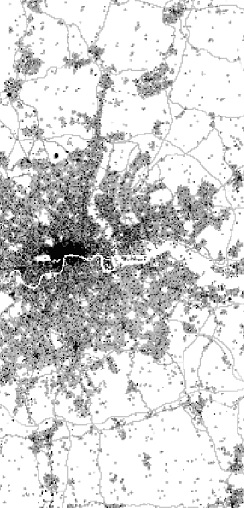
FAQs
A quick run down of frequently asked questions
How do I licence Population24/7?
Version 2-0 is a fully open version, with all input datasets and any derived output datasets being available for re-use under the Open Government Licence or Creative Commons Attribution 4.0 International licence.
Data citation: Martin, D., Cockings, S. Harfoot, A., Smith, A. D. (2021) Population24/7: an open gridded population dataset for England and Wales. GeoData, University of Southampton.
Any subsequent publication or redistribution should include the relevant data acknowledgements.
Data acknowledgements:
Contains Office for National Statistics, Department for Education, Department for Transport, Welsh Government and NHS Digital data licensed under the Open Government Licence. Contains data published by HESA under a Creative Commons Attribution 4.0 International License. Contains data adapted from Official Statistics © British Tourist Authority 2016. Contains OS Open Data Crown copyright and database right 2016 and Royal Mail data © Royal Mail copyright and database right 2016 free to use under the Open Government Licence. Full per-dataset citations contained in Input Data Files archive.
If I register, how will you use my information?
The information which you provide on registering to download the data will be used to help us understand the types of organization and use cases that Population24/7 is being used for. You will have the option to be added to our mailing list to find out about future enhancements to the datasets and Population24/7 events. However, you must provide a valid email address to receive download links.
Can I use Population24/7 on commercial projects?
Yes. The data are available for commercial use and re-use provided that the citation is made.
How accurate is Population24/7?
This is a complex question as it relies on having a definitive high resolution comparator dataset which gives counts of how many people are present in small areas at specific times. There is currently no such definitive comparator dataset and we are currently working on various approaches to validation of the estimated counts at the small area level. The estimation method is one of population reallocation, in which input population counts are redistributed over space, hence the population contained within a bounded model can neither increase nor decrease. If input datasets do not account for the entire population, for example visitors or inward commuters, then they will not be included in the resulting estimates..
Why did you not use a higher resolution spatial referencing such postcode or building locations?
It would have been possible to use more detailed locational references for some elements of the population distribution, and we have done this in some of our own research projects, but this involves further estimation of the detailed spatial distribution of age-specific population counts and would greatly have increased processing times. This dataset has been built as a general purpose demonstrator which does not justify the use of high resolution spatial references across the entire country. We are investigating the use of a range of new and higher resolution data sources as part of our Population24/7NRT project.
What do I need to be able to use Population24/7
There are two ways of using the material provided in this site. The download facility can be used to download sample ASCII grid format population estimates produced by the SurfaceBuilder247 program. We have deposited the full input dataset with the UK Data Service. Users wanting to generate their own models, may obtain the SurfaceBuilder247 executable from the Software page directly to construct alternative models from the same input data, or may assemble their own input datasets covering different population groups, geographic regions or time periods of interest. Users wishing to do this should read the user guide and refer to the Input Dataset examples as a guide to the required file formats. You may be interested in the following paper, which describes an application using datasets for a study region in Italy.
Renner, K., Schneiderbauer, S., Pruß, F., Kofler, C., Martin, D., & Cockings, S. (2018). Spatio-temporal population modelling as improved exposure information for risk assessments tested in the Autonomous Province of Bolzano. International Journal of Disaster Risk Reduction, 27, 470-479 https://doi.org/10.1016/j.ijdrr.2017.11.011
What format is the downloadable data?
Modelled estimates can be obtained from the download page as Geotiff files, which are widely supported by GIS software, including ArcGIS and QGIS and can also be previewed in many basic image viewers.
Each downloadable data file is a raster dataset containing estimated values for a specific population or sub-group, at a specific reference day and time, at a spatial resolution of 200m x 200m. Multiple data layers are selectable, representing different population sub-groups and times. Downloads may be made of any combination of 100km squares (each 500 x 500 grid cells) covering England, or the entire England dataset in one file. These data do not cover any parts of Scotland or Wales that fall within the area of the grid. Not all grid cells contain population, so a no data value is defined to reflect this. In the Population24/7 data, this is -9999. Any data values other than this are the population of the grid cell as estimated by Population24/7. It is important to understand that these are floating point estimates, not integer population counts.
What do the download filenames mean?
The filenames (selectable from the drop-down list) comprise a sequence of codes separated by underscore "_" characters, here using the example "Eng_2011_v2-0_OTT_~0_4~02-00~17-08-2011_Total"
- Eng = dataset coverage is England
- 2011 = the reference year for the input datasets is 2011
- v2-0 = this is version 2.0 of this model
- OTT = out of term time (the alternative is TT = term time)
- ~0_4 = the age group is 0-4; other codes (in combination) include AllAges, HE = higher education students; NSTU = non-students; OV65 = aged 65 and over
- ~02-00 = the reference time is 02.00 (i.e. 2am)
- ~17-08-2011 = the reference date for this model
- Total = these are population totals; the SurfaceBuilder software will also output intermediate layers
Do you have any plans for a full UK Coverage?
Due to differences in the available input data from censuses and administrative data sources across the UK, we do not currently plan to include data for the separate UK nations within a single downloadable dataset.
How do I know which files to download for my area of interest?
We are currently providing the data cut to the Ordnance Survey 100x100k grid tiles, which are denoted with different letters (e.g. SU, TQ etc). If you look at the map on the download page you can choose which area(s) you wish to download.
How do we report issues / feedback on the dataset?
Please send any queries or any issues about the dataset to pop247@geodata.soton.ac.uk
We are also asking people to tell us what they think about the dataset so would encourage you to fill out the feedback form where you can help set future direction for the product.
Do I need to provide an acknowledgement for the dataset when I build an application or website that uses Population24/7?
Yes. Please provide a citation to Population24/7 in reports and on mapping as stated in "How do I licence Population24/7" above.
Are there other journal papers about the Population24/7 work?
- Martin, D., Cockings, S., & Leung, S. (2015). Developing a flexible framework for spatiotemporal population modeling. Annals of the Association of American Geographers, 105(4), 754-772. https://doi.org/10.1080/00045608.2015.1022089
- Smith, A. D., Newing, A., Quinn, N., Martin, D., Cockings, S., & Neal, J. C. (2015). Assessing the impact of seasonal population fluctuation on regional flood risk management. International Journal of Geo-Information, 4(3), 1118-1141. https://doi.org/10.3390/ijgi4031118
- Smith, A., Martin, D. J., & Cockings, S. (2016). Spatio-temporal population modelling for enhanced assessment of urban exposure to flood risk. Applied Spatial Analysis and Policy, 9(2), 145-163. https://doi.org/10.1007/s12061-014-9110-6
- Renner, K., Schneiderbauer, S., Pruß, F., Kofler, C., Martin, D., & Cockings, S. (2018). Spatio-temporal population modelling as improved exposure information for risk assessments tested in the Autonomous Province of Bolzano. International Journal of Disaster Risk Reduction, 27, 470-479. https://doi.org/10.1016/j.ijdrr.2017.11.011

